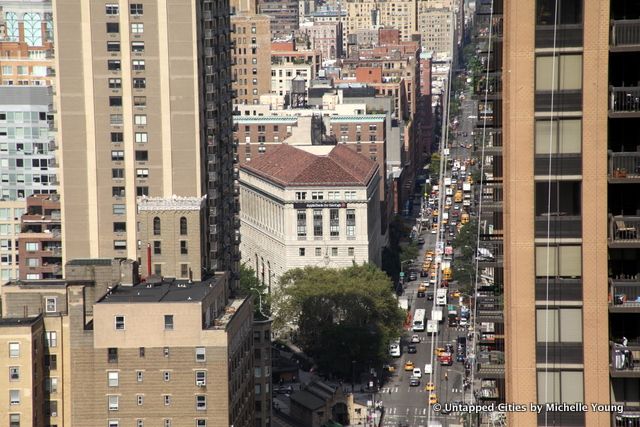Last-Minute NYC Holiday Gift Guide 🎁
We’ve created a holiday gift guide with presents for the intrepid New Yorker that should arrive just in time—


On Quora, we came across a great Cities 101 question about the logic behind the selection of Manhattan’s Cross Streets (and one of our photographs of Columbus Circle in the answer). In a thorough recap, Raj Bhuptani, a ’13 Statistics graduate from Harvard and a Quantitative Research Analyst at Two Sigma Investments, provides an answer which he has allowed us to republish here (additional hyperlinks added by us).
I love this question, not least because I find few things more enthralling than the Manhattan street grid. Here is the relevant passage from the 1807 plan of John Randell:
Those passages which run at right angles to the avenues are termed streets, and are numbered consecutively from one to one hundred and fifty-five. The northerly side of number one begins at the southern end of Avenue B and terminates in the Bower lane; number one hundred and fifty-five runs from Bussing’s Point to Hudson river, and is the most northern of those which is was thought at all needful to lay out as part of the city of New York, excepting the Tenth avenue, which is continued to Harlem river and strikes it near Kingsbridge. These streets are all sixty feet wide except fifteen, which are one hundred feet wide, viz.: Numbers fourteen, twenty-three, thirty-four, forty-two, fifty-seven, seventy-two, seventy-nine, eighty-six, ninety-six, one hundred and six, one hundred and sixteen, one hundred and twenty-five, one hundred and thirty-five, one hundred and forty-five, and one hundred and fifty-five–the block or space between them being in general about two hundred feet.
So the official list of major cross streets is
Note that there are fifteen major cross streets, almost the same as the number of avenues (16)… ignoring the minor cross streets, you can thus envision Manhattan as roughly a 15 x 15 Cartesian grid, stretched in the uptown-downtown direction because the island is an oblong rectangle.
As Lee Semel‘s answer indicates, many of these streets (especially the first several) are located where Broadway intersects one of the avenues. And not coincidentally, these intersections also happen to mark the spots of many of Manhattan’s most famous “Squares“:

14th Street intersects Broadway at 4th (Park) Avenue, and this intersection is Union Square.
23rd Street intersects Broadway at 5th Avenue, and this intersection is Madison Square. (OK fine, technically Broadway and 5th Avenue intersect closer to 24th Street. But 23rd Street was likely chosen because it marked the southern boundary of the Grand Parade, of which Madison Square Park is now a small subset.
34th Street intersects Broadway at 6th Avenue, and this intersection is Herald Square. (OK fine, technically Broadway and 6th Avenue intersect at 33rd Street, which is known as Greeley Square–and really the two squares merge into one chaotic square with cars, pedestrians, outdoor chairs, and Macy’s shoppers.)
42nd Street intersects Broadway at 7th Avenue, and this intersection is Times Square. The intersection and the stretches of Broadway and 7th Avenue for a few streets in either direction form a “bowtie” shape, leading to “The Bowtie” as a nickname for Times Square which people no longer use, possibly because all of the other Broadway/Avenue intersections form bowties too.

59th Street intersects Broadway at 8th Avenue, and this intersection is called Columbus Circle. (But the major cross street is 57th, not 59th… similar to 23rd Street, 57th Street was likely chosen because it was the northern boundary of Bloomingdale Square, another park which no longer exists.) Now 59th forms the southern border of Central Park, and is thus somewhat of an honorary major cross street.

66th Street intersects Broadway at 9th (Columbus) Avenue, and this intersection is… nothing [Editor note: Technically it’s Tucker Square, home to the Greenmarket and the waffle truck]. Broadway bends a bit to the left at 59th Street, and in addition the avenues start becoming a bit closer together, so Broadway intersects 9th Avenue “too soon”, at 66th Street. In the 1800s this area was already very far north of the extent of “developed” Manhattan, and so it seemed a waste to add another major cross street “just” six blocks uptown of the previous one. Still, 66th Street is another honorary major cross street today… its intersection with Broadway and 9th Avenue is home of Lincoln Center.
72nd Street intersects Broadway at 10th (Amsterdam) Avenue, and this intersection is called Verdi Square [Editor note: Just north of Verdi Square is the neo-Renaissance palazzo style bank Apple Bank, now also apartments.] This is not a major square in the league of the ones above… but it has a history of being a meeting place for drug deals. 72nd Street also marks Strawberry Fields, the area of Central Park in memorial of John Lennon.

After this, Broadway curves to the right and becomes parallel to the avenues, continuing in this way until it merges with 11th (West End) Avenue at 107th Street. As a result, there are no more major “Squares” resulting from triple intersections. The next major cross street is at 79th Street, likely chosen because 79th Street marks the center of the old Manhattan Square (now occupied by the Museum of Natural History). The next major cross street is 86th Street, and major cross streets continue to occur approximately every ten blocks until the “end” of (1800s) Manhattan: 96th Street, 106th Street, 116th Street, 125th Street, 135th Street, 145th Street, 155th Street.
Next check out 14 Fun Facts about the Original Commissions Street Grid for NYC and read about why New York City’s squares aren’t actually square. Read more from our Cities 101 series about how stuff works in the city.
Subscribe to our newsletter